Screen Image -V- Sound Image
In most cinemas the physical size of the sound system is small compared to the screen and therefore the sound experience does not match the experience of the picture. Small speaker systems disperse as a point source at the inverse square law from the screen, whereas the picture is radiating from the whole screen area. The general view of the majority of people is that sound is only 10% of the cinema experience.

Cinema is successful because the picture appears to have no boundary when viewed on the big wide screen. So why not remove the boundary of a small low fidelity sound system, and make the sound as big as the picture in terms of experience.
Imagine being in a rain forest and very attentive to the sounds around you, hearing subtlety of detail which extends into infinity. Record this, go home and play it back on a small stereo. It will only be recognisable because of remembering. Turning up the volume does not make it sound real. It is made real by removing the boundary of a small low fidelity sound system and stepping into large scale 4way active electro-acoustic technology.
Inverse square law refers to energy radiating from a point source. When the reflected light (image) radiates from the screen, the inverse square law does not begin at the screen, but from the projector, at the rear of the cinema, or the same distance from an imaginary point behind the screen.

The projected image from the screen always looks big wherever we sit in the cinema. This is the reason home cinema can never create the same experience as going to a large theatre. This is similar to why the energy from the sun or the sun's size does not appear to decrease by moving another 30m (100ft) further away from it at the distance of the earth.
We can all understand that using a small home cinema screen in a large cinema, and simply increasing the luminance (brightness) does not make the image appear larger. But this is precisely what most people (including those that are technical) falsely believe about sound systems. Putting a small home cinema sound system behind the screen and simply turning up the volume does not make is sound like a large cinema sound system. It will only sound like a small sound system with the volume turned up. This point is made so not to confuse loudness with sound stage or sound image, which refer to propagation directivity and radiating area.
Wavelength propagation The difference between the wavelengths of various colours of light are less than 1 octave, approx 1/2 micro meter. We can assume that all light from the screen radiates at a similar wavelength which is very small compared to the radiating area (screen size). Therefore the image will appear consistent in reference to screen size and observed distance.
However this is not so with sound. Sound is kinetic energy (air vibration) at very low velocity of 344meters /second. Wavelength at 100Hz = 3.4m (11ft) Wavelength at 10kHz = 34mm (1.4in) a large ratio difference of 100:1
For the sound image (dispersion and propagation) to be consistent over the frequency and dynamic range, the acoustic radiating diameter should approx = wavelength, increasing x 2 for each octave decrease. This imaginary ideal is impossible because the speaker would have to be as large as the screen at 20Hz wavelength = 17m (56ft).
The average home cinema speakers are approx 4in - 8in. The lower frequency wavelengths are approx x10 to x100 larger than the speaker diameter. The higher frequency wavelengths are approx 1/10 to 1/2 speaker diameter. Therefore the sound image (dispersion) will be inconsistent across the frequency spectrum, also the spectral balance of low to high frequencies will change with power.
The average commercial cinema speaker system has 2 x 15in speakers which are small compared to bass wavelengths. whereas the high frequency horn is matched to the higher frequencies and has a different behaviour to the front loaded 15in speakers. The lower frequency energy from the front loaded cone speakers lags behind as the power increases.

Horns Theoretically the sound waves at the horn mouth are not as curved as if coming from a front loaded cone speaker. The sound waves from the horn appear slightly straighter as if radiating from a larger surface area, similar to the screen but on a smaller scale. This is why the hi-frequency horn appears to have a more forward projected sound image and greater voice clarity compared to front loaded cone speakers.

 As most cinema sound systems are 2 way passive with 15in front loaded speakers, it is best to get as much of the sound spectrum as possible to come from the hi-frequency horn and take advantage of its increased directivity. Manufacturers of most horn 2in compression drivers recommend a crossover frequency of no lower than 800Hz at specified power.
As most cinema sound systems are 2 way passive with 15in front loaded speakers, it is best to get as much of the sound spectrum as possible to come from the hi-frequency horn and take advantage of its increased directivity. Manufacturers of most horn 2in compression drivers recommend a crossover frequency of no lower than 800Hz at specified power.
500Hz crossover Providing the designers of the 2 way speaker systems are willing to limit the power to the horn compression driver to less than 1/2 of its specified power, it is possible to lower the crossover to 500Hz before the driver diaphragm is at risk of being damaged. This also requires the horn length and mouth be made larger than normal, sometimes described as long-throw or constant directivity horns.
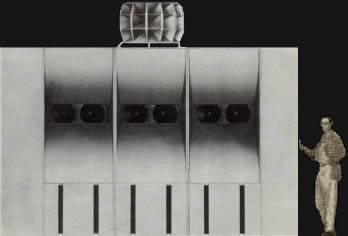
Many large sound systems of the past were 2 way passive and had very large extended horn shaped baffles for the low-frequency 15in speakers. This helped obtain a similar directivity and efficiency to the hi-frequency horn on top. Early valve amplifiers were approx 30 to 60 Watts which provided a strong motivation for design engineers to make the speaker system as efficient as possible. The overall sound quality appeared consistent over the frequency range, compared to the majority of today's smaller cinema sound systems.

The aim is for the sound to match and picture so they both appear in the same proportion every where in the cinema. This requires the sound spectrum to be divided into 4 sections. The below pic shows the large variation of wave lengths over the sound spectrum that have to be managed by the speakers is each section.
Above 700Hz compression drivers + horns are ideally suited to the smaller wavelengths of higher frequencies. Below 700Hz in larger 300+ seats cinemas the 15in speakers should be placed in horn shaped cabinets to increase the effective radiating area and directivity to match the high frequency horns. Below 100Hz the wavelengths are so long that the floor and walls are able to act as an extension of the horn cabinets and therefore maintaining their directivity.
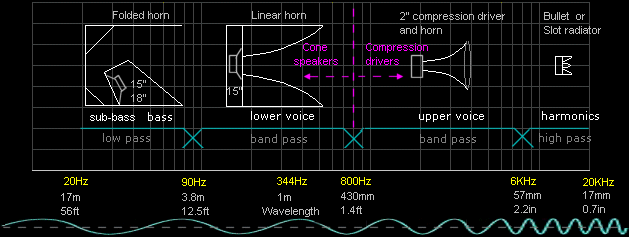
Active All large sound systems require separate amplification for each of the frequency bands to achieve maximum performance with minimal error and distortion. Active management also eliminates any possibility of inter-modulation between the different frequency sections. The Lenard K4 system uses a separate amplifier for each speaker component. Electronic crossovers should be 4th order (24dB/octave) and have time alignment correction available.
Jokes are often made by technical people that all sound system problems could be solved if everyone in the cinema wore headphones. Sound fidelity is highest at close proximity to a sound system that radiates from a point source. Monitor systems in recording studios for mixing cinema sound use smaller sound system similar to the Opal speakers in the pic below on left.

Diffusion Radiating sound from large areas with multiple speaker components increases the possibility of similar frequencies to interact causing diffusion. The extreme of this problem is heard with large concert PA systems. The radiating area of an average cinema sound system is approx 0.75m² (8ft²). The Lenard K4 radiating area is approx 5m² (50ft²). Each of the large cinema sound systems in the below pics have different advantages. All approaches are excellent in performance and are designed to minimise the problems of diffusion when dispersing sound from large areas.
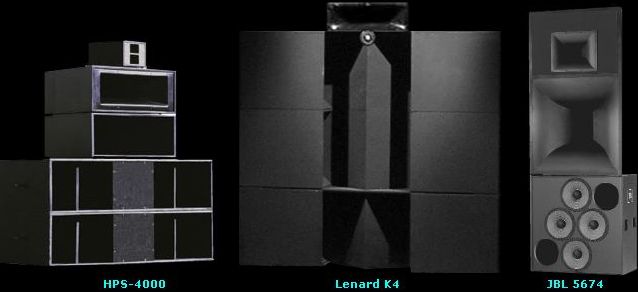
The HPS-4000 is a 4 way passive system that follows the best traditional convention of horn designs. Because the horns are forward facing they require a larger distance behind the screen which is not available in many cinemas that put screens very close to the wall. Depth 1,117mm (44in)
www.hps4000.com
The JBL 5674 is JBL's largest 3 way cinema system which reflects the traditional approach of favoring the upper voice range, typical of what we recognise cinema sound to be. The system is designed be placed in a large baffle wall to increase the directivity of the front loaded 15in speakers. Depth 813mm (32in)
www.jblpro/pages/cinema.com
The Lenard K4 is a 4 way fully active system that requires minimum stage distance behind the screen and does not require the added expense of a baffle wall. Depth 457mm (18in) This unique rotational approach owes its origin to the industrial designer Michael Dixon who stated that increasing lower voice radiating area (100Hz - 800Hz) to improve propagation would add extra realism to the cinematic sound experience, which proved to be correct.
www.ddd.net.au
Conventional cinema systems require the (.1) information is sent to an independent amplifier and subwoofer speaker. With the Lenard K4 system the (.1) information is electronically remixed with its own gain control to the (left-center-right). The .1 sub-bass is delivered through all the folded horn bass bins generating close to a plain wave front, providing vastly greater impact.
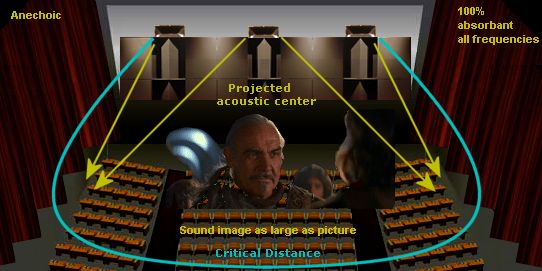
Projected acoustic center The aim of all large scale systems is to create the experience that the acoustic center is projected forward (approx 6dB) into the audience, giving a feeling that the sound appears to come from half the distance that it actually is. Providing the cinema is acoustically treated to be close to anechoic as possible the projected acoustic center gives us the experience of Synesthesia.
Synesthesia
Synesthesia is the experience we have when one sensory system affects another. A passing scent can evoke a strong memory; visually we can describe a colour as warm red or cold blue. Music can influence our feelings and how we experience seeing a picture. Synesthesia stems from the function of our imagination carrying sensory experience into altered states. Capturing one of our senses (sound) into 3D experience, caries the other senses with it, giving the picture a larger 3D perception and enhance our enjoyment of the movie.
Approx 1 in 30 films are created by people who have this understanding and skill. The dialogue leads with visual form edited to the music score 'Form follows content'. This procedure is fully thought out in pre-production. Often the (left-center-right) speakers are utilised as a tri-stereo field giving a full auditory depth of field to the picture.
Synesthesia also has an equally negative effect on reducing our enjoyment of the film. Limitations in recording skills often result in the trend to use excessive dynamic compression. Limitations of bandwidth and dynamic range, imposed in the recording process and the projector decoding A Chain, combined with limited fidelity of the B chain speaker system, including poor acoustics of the cinema, accumulate in having an overriding negative effect on the experience of a film.
- Reverberation from cinema walls, distances us from the film as flatness.
- Harsh sound alignment causes listening fatigue and contributes to physical discomfort.
- Excessive dynamic compression limits the illusion of distance or perspective in the picture.
- Poor fidelity speakers colour the sound, unconsciously affecting our visual experience of colour vibrancy.
3D Spatial realism
Stereo image was discovered early in the recording industry. Two microphones spaced similarly to our ears, recorded onto separate tracks and played back through headphones. The result is a three dimensional (3D) experience of the music, similar to the visual photographic 3D stereo image.
Production techniques for 3D stereo imaging have improved over time, but are dependent on the fidelity of the sound system and minimal reverberation of the room. 3D stereo imaging cannot be heard from small low fidelity speaker systems, or in reverberant cinemas.
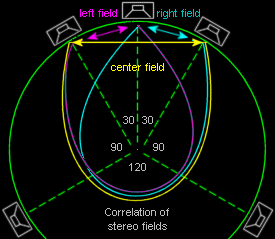
3D spatial realism through speakers requires a minimum of 2 stereo fields. A single field from only 2 speakers enables one part of the 3D experience to be obtained. As in the above pic three speakers can create three stereo fields from which fields 1 and 2 create spatial localisation. Sound fields can be positioned and maintained into a relative stable left-center-right correlation over a 60deg listening angle.
Surround speakers are for diffused environmental effects, also the 5.1 protocol for home cinema puts the rear speakers at too great an angle to be correlated into stereo fields.
The objective is to match the sound with the moving image, enabling the picture to come alive. This requires sound to carry detail represented in the picture. If done well, the sound caries the moving image from 2 to 3 dimensions. This effect is called Synesthesia.


